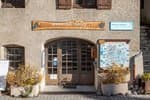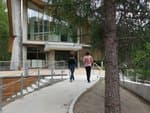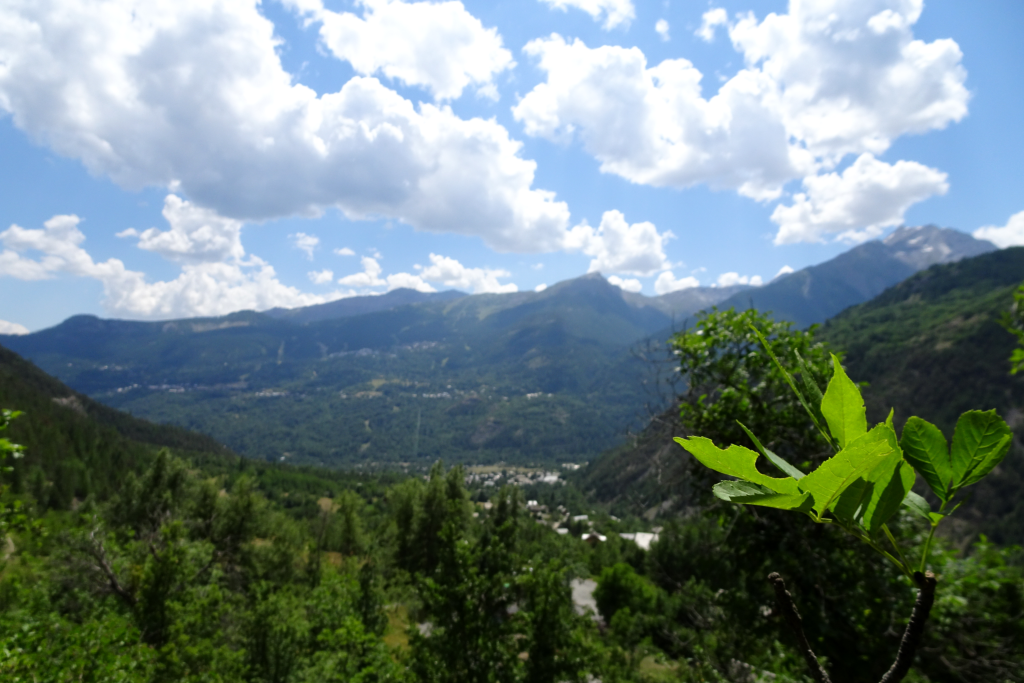
Exploring the hamlets of Vallouise and Pelvoux
“You think you know the hamlets of Vallouise and Pelvoux when you go there by road. But approaching them via the footpaths is another experience altogether. Not to mention the pleasure of walking on these little-trod paths.” Marie-Geneviève Nicolas, park ranger at the Parc National des Écrins
Description
Waysigning: one green dot and once white dot
From the Park Centre ("Maison du Parc"), follow the road to Puy Saint-Vincent.
- Take the path on the left towards Les Parchers and continue heading in this direction. The track runs above the Gyronde and then comes to a bridge below the hamlet of Le Grand Parcher. Cross this bridge and then cross the D994E (take care) and follow the narrow road leading up to this hamlet.
- A short distance beyond the chapel, take a path on the left to Petit Parcher. Join the road right and follow this for a short distance.
- Take the path for La Casse. Carry on up through La Casse and, at the top where the houses come to an end, take the path leading to the Rocher Pointu. Further on, continue straight ahead towards the Rif Paulin and Pelvoux-Le Sarret. Cross the Rif Paulin mountain stream over a sill and then continue along the canal.
- Head down towards Pelvoux - Le Poët. At the lower end of the hamlet, cross the mountain stream La Juliane via a narrow road and then drop down to the D994E.
- Cross the D994E (take care) to take the track opposite which leads to the Gyr mountain stream. Stay on the left-hand bank and follow the track leading to Vallouise.
- Cross the Gyr to carry on along its right-hand bank, passing close to the campsite, to return to the Park Centre.
- Departure : Park Centre ("Maison du Parc"), Vallouise
- Arrival : Park Centre ("Maison du Parc"), Vallouise
- Towns crossed : Vallouise-Pelvoux
Altimetric profile
Recommandations
It is possible to complete only some sections of this loop. In particular, at the Rif Paulin you can drop back down to Vallouise via Pra Peyron or, instead, park at the Vallouise cemetery car park, set off from Rivière Pont, climb up via Pra Peyron to reach the Rif Paulin and, from there, carry on towards Le Poët and return to Vallouise following the described route.
Check weather conditions before setting off.
Rescue services contact details: Secours Montagne (Mountain Rescue): +33 (0)4 92 22 22 22 or 112
Show consideration for the work of farmers, livestock keepers and owners
Close all gates behind you
Take your litter home
Do not take shortcuts across pastureland
Information desks
Place de l'Eglise, 05340 Vallouise
Vallouise Park house
, 05290 Vallouise
Information, documentation, models, exhibitions, screenings, product sales and works of the Park. Guided tours for school, reservation required. The new Park House opened in Vallouise since June 1, and offers visitors an interactive permanent exhibition inviting to explore the area and its heritage. A temporary exhibition space will allow a renewed offer. Finally, the device is completed by an audiovisual room to organize screenings and conferences Free admission. All animations of the Park are free unless otherwise stated.
Transport
Public transport >> www.pacamobilite.fr
Consider car-sharing >> www.blablacar.fr
For more information, ask at the Tourist Information Office nearest to the trail starting point.
Access and parking
9 km from L'Argentière-La Bessée, take the D994E.
Parking :
Sensitive areas
Short-toed snake eagle
- Impacted practices:
- Aerial,
- Sensitivity periods:
- MarAprMayJunJulAugSep
- Contact:
- Parc National des Écrins
Julien Charron
julien.charron@ecrins-parcnational.fr
20 points of interest
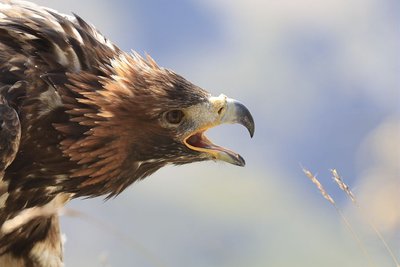
Aigle royal - Cyril Coursier - Parc national des Écrins  Fauna
FaunaThe sun bird
So what is the identity of this sun bird? It's the royal, or golden, eagle of course. Although it is telling the time here, in the surrounding natural landscape it hunts marmots. But what becomes of it in winter when the marmots hibernate deep in their burrows? It's a lean time. It has to make do with a hare or ptarmigan, and in particular the carcasses of chamois which have not survived the winter or have been killed in an avalanche.

La sittelle torchepot - Damien Combrisson - Parc national des Écrins  Fauna
FaunaThe wood nuthatch
With its strident calls, this little acrobat gets itself noticed. With a blue-grey back and a black stripe over its eyes, it works its way down the tree trunks upside down in search of insects. It nests in old woodpecker nests but if the diameter of the entrance is too large it reduces it with mud, to protect its young from predators. Hence its French name torchepot (a reference to edging the rim of a vessel).
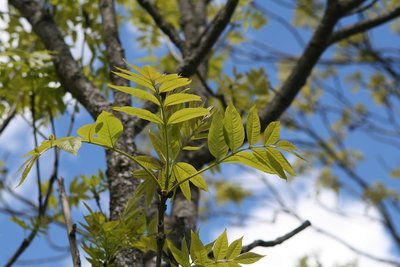
Un frêne - Marie-Geneviève Nicolas - Parc national des Écrins  Flora
FloraThe ash tree
Even in winter, the ash can be recognised from its large black leaf buds. The leaves are compound. A pioneer species that grows easily, the ash has long been used by man for everyday needs: its foliage was used to feed cattle and its hard, flexible wood was used to make a variety of objects such as tool handles. Its French name frêne often appears in local place names too: Freissinières (frêne noir - black ash), Le Freney etc. Evidence of its historical importance to human communities..

Hélice des Alpes - Damien Combrisson - Parc national des Écrins  Fauna
FaunaThe Alpine copse snail
On the damp banks of the stream, hidden in the grass, is a snail with a beautiful golden brown shell speckled with brown, decorated with a dark spiral stripe. It has a black body. The alpine copse snail is relatively rare and, as its name suggests, it is found in the Alps. It is a sub-species of the ordinary copse snail, which is present across Europe.
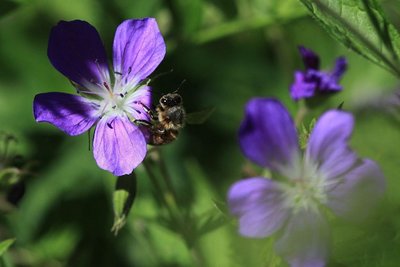
Géranium des bois - Marc Corail - Parc national des Écrins  Flora
FloraWood cranesbill
The path is edged with large clumps of a plant with purple flowers, the wood cranesbill. The leaves are palmate and divided into 5 to 7 incised and indented lobes, This common plant grows in meadows and cool woods. The «geraniums» we see on balconies are in fact pelargoniums, distant cousins originally from South Africa and cultivated for ornamental purposes.
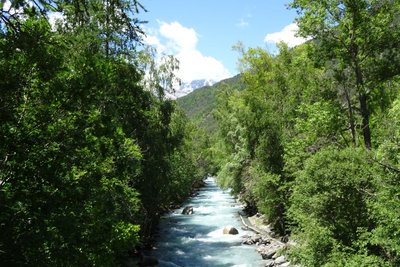
La Gyronde - Office de tourisme Pays des Écrins  Water
WaterThne Gyronde
No, we're not in south-west France where the Gironde flows! The Gyronde (spelt with a «y»!) is the river that flows between Vallouise and L'Argentière-La Bessée, where it flows into the Durance. It originates from the Gyr and Onde mountain streams which merge in Vallouise.
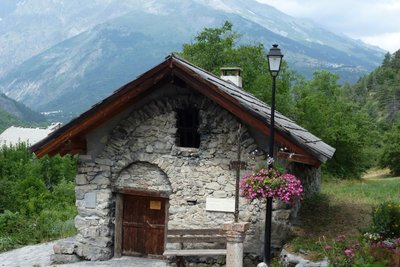
Le four banal du Grand Parcher - Office de tourisme Pays des Écrins  Vernacular heritage
Vernacular heritageThe hamlet of Parcher
The hamlet of Grand Parcher stands on the alluvial cone formed by the Grand Parcher mountain stream, and on either side of it. It is made up of several old houses and the seventeenth-century chapel of Saint-André. It has two sun dials painted onto its walls. One of them bears the saying HORA INCERTA CUNTIS, ULTIMA MULTIS (This hour is uncertain for all, it is the last hour for many). Food for thought!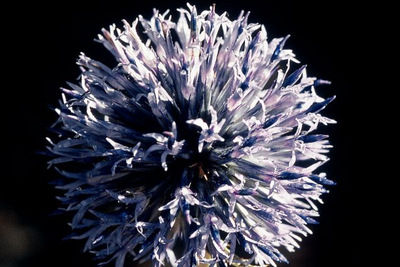
L'échinops à tête ronde - Bernard Nicollet - Parc national des Écrins  Flora
FloraThe great globe thistle
On the edge of the path grows a tall plant with quite wide and smooth leaves, and completely round whitish or very pale blue flower clusters. This is the great globe thistle, a relatively rare plant. It is a cousin of the southern globe thistle which can be seen everywhere in dry places. This one is smaller and has clusters of bluish flowers and spiny leaves.
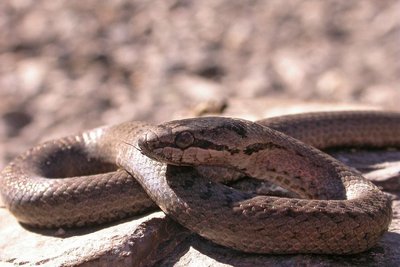
La coronelle lisse - Damien Combrisson - Parc national des Écrins  Fauna
FaunaThe smooth snake
The smooth snake is a non-venomous colubrid snake, which adopted the bad idea of resembling the venomous vipera aspis, which has led to it being killed indiscriminately. We must remember, however, that both the vipera aspis and the smooth snake are protected species. It can be recognised in particular by the black stripe over its eye and on its round pupil (which helps to distinguish colubrids from vipers, which have a slit pupil).

L'ascalaphe soufré - Blandine Delenatte - Parc national des Écrins  Fauna
FaunaThe owly sulphur
A strange insect, part butterfly, part dragonfly, with large black antennae, transparent wings tinted with yellow or white and with well-defined veining, flies over the meadow during the hottest part of the day. It is the owly sulphur. Owlflies are members of the Neuroptera (net-winged) order and are cousins of ants and lacewings. They are predators of small insects, flies in particular.

Torrent de Paulin - Office de tourisme Pays des Écrins  Water
WaterMountain land rehabilitation projects
Stream correction dams have been built by RTM (Mountain Land Rehabilitation), a branch of the National Forestry Agency. The purpose of these structures is to limit erosion and mountain stream flooding. The RTM has been in existence for a long time, set up in the late nineteenth century. At that time, the slopes where much more sparsely wooded than they are today, and erosion was a very significant problem.
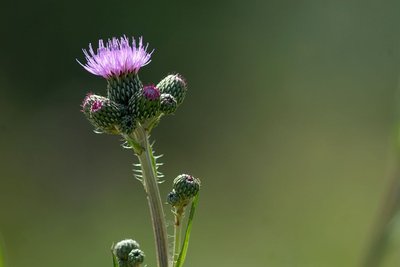
le cirse de Montpellier - Mireille Coulon - Parc national des Écrins  Flora
FloraThe Montpellier thistle
A large plant grows along the canal side; a sort of thistle although it is not spiky: the Montpellier thistle. Its oval, pointed leaves are edged with large, stiff but non-spiky cilia. Its flowers are pink. In France, it is only found in the Alps and the Pyrenees and a few departments in the south. Associated with wet areas, this species has become rare in many regions because of damage to its habitat.

La carline à feuilles d'acanthe - Bernard Nicollet - Parc national des Écrins  Flora
FloraThe acanthus-leaved thistle
This is a hot, west-exposed slope with rocky ground. The plant life reflects this situation: the narrow-leaved lavender and acanthus-leaved thistle grow here. The latter looks like a large sun with its very big flower head which quickly turns golden and its leaves radiating out around it. It often used to be hung on house doors... but much better to leave it lighting up the stony meadows!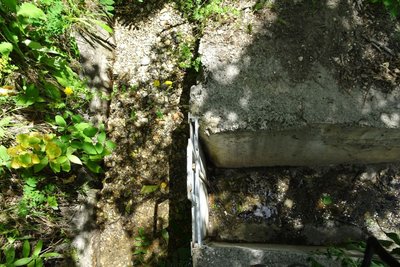
Canal du Béal Neuf - Office de tourisme Pays des Écrins  Water
WaterThe role of the canals
Irrigation of meadows and private gardens; preservation of traditions; the promotion of social contact through collective canal maintenance operations carried out by local people; development of canals to create trails for tourists and locals... The canals have fulfilled a variety of roles, hence the benefit of conserving and maintaining them.
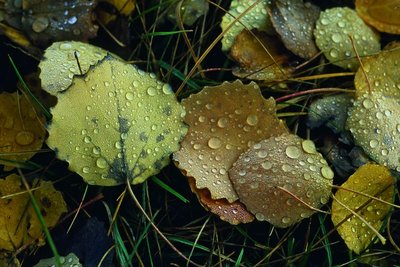
Des feuilles de tremble - Bernard Nicollet - Parc national des Écrins  Flora
FloraThe aspen
On the right, a stand of aspens with smooth, greenish trunks and rounded, crenelated leaves take on magnificent colours in autumn. The stem, or petiole, of aspen leaves is flat and twisted, so it can be caught by the slightest breeze making the foliage «quake» hence its common name, the quaking aspen.
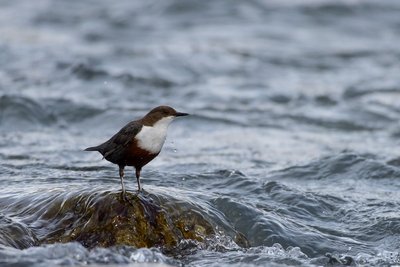
Cincle plongeur - Mireille Coulon - Parc national des Ecrins  Fauna
FaunaThe white-throated dipper
Perched on a rock in the middle of the river, a squat bird with a short tail, brown with a large white bib, bobs up and down with his tail in the air. He then dives and only reappears a few moments later. This is how this bird hunts, diving into the water and then walking against the current along the river bed searching for aquatic insect larvae, small crustaceans or small fish, lifting pebbles with its beak to dislodge them.
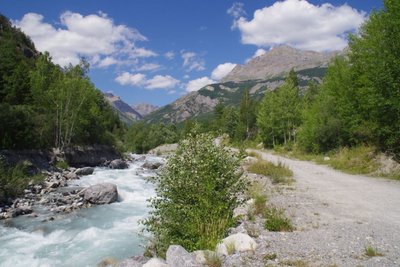
Forêt au bord du Gyr - Office de tourisme Pays des Écrins  Flora
FloraForest on the water's edge
This small wood is a fragment of the riparian forest: natural forest growing adjacent to a body of water. Reduced everywhere due to urbanisation, this type of forest is made up of alder, willow and oak, and also poplar, birch and aspen, among others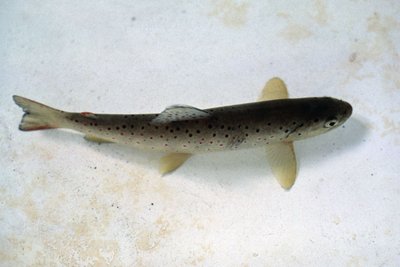
La truite fario - Parc national des Écrins  Fauna
FaunaThe trout
But what's the angler angling for? The brown trout of course! This is the mountain fish par excellence, with a streamlined body to withstand the current more efficiently and light brown skin speckled with black and red. It lives in cold, oxygen-rich waters.
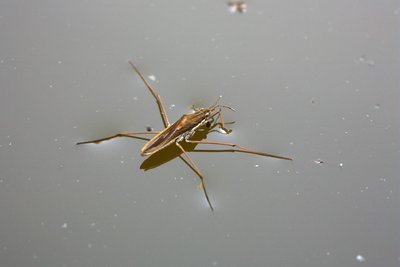
Un gerris - Bernard Nicollet - Parc national des Écrins  Fauna
FaunaThe gerris
Some strange creatures are moving jerkily over the surface of the water: Gerrises, insects related to bedbugs. Like a true insect, they have six legs and they «skate» across the water using their intermediate and hind legs which are covered in hairs to make them water-resistant. They are carnivorous and anything on the water surface, dead or alive, is good to eat! They catch their prey with the forelegs, sucking up the juices with their strong proboscis!
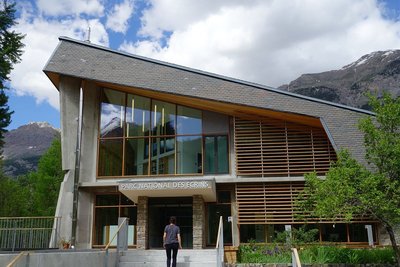
La Maison du Parc de Vallouise - Thierry Maillet - Parc national des Écrins  History
HistoryThe Vallouise Park Centre
Vallouise Pelvoux is a municipality within the Parc National des Écrins. Renovated in 2014, the Park Centre ("Maison du Parc") houses the offices of the local Park staff and has a spacious visitor reception area. It offers a permanent interactive exhibition inviting discovery of the territory and its heritage features, a temporary exhibition space on the upper floor and an audiovisual room (screenings and talks). It is currently in the process of applying for the "Tourisme et Handicap" tourism and disability label. Admission is free and so, too, are most of the activities in offer.
Source

Report a problem or an error
If you have found an error on this page or if you have noticed any problems during your hike, please report them to us here:

